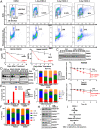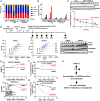Adaptive exchange sustains cullin-RING ubiquitin ligase networks and proper licensing of DNA replication
- PMID: 36037385
- PMCID: PMC9456757
- DOI: 10.1073/pnas.2205608119
Adaptive exchange sustains cullin-RING ubiquitin ligase networks and proper licensing of DNA replication
Abstract
Cop9 signalosome (CSN) regulates the function of cullin-RING E3 ubiquitin ligases (CRLs) by deconjugating the ubiquitin-like protein NEDD8 from the cullin subunit. To understand the physiological impact of CSN function on the CRL network and cell proliferation, we combined quantitative mass spectrometry and genome-wide CRISPR interference (CRISPRi) and CRISPR activation (CRISPRa) screens to identify factors that modulate cell viability upon inhibition of CSN by the small molecule CSN5i-3. CRL components and regulators strongly modulated the antiproliferative effects of CSN5i-3, and in addition we found two pathways involved in genome integrity, SCFFBXO5-APC/C-GMNN and CUL4DTL-SETD8, that contribute substantially to the toxicity of CSN inhibition. Our data highlight the importance of CSN-mediated NEDD8 deconjugation and adaptive exchange of CRL substrate receptors in sustaining CRL function and suggest approaches for leveraging CSN inhibition for the treatment of cancer.
Keywords: CRISPR screen; CSN5i-3; Cop9 signalosome; DNA replication; deneddylation.
Conflict of interest statement
Competing interest statement: Y.Z. is an employee of Amgen. D.L., C.-M. L., and R.J.D. are employees and shareholders of Amgen. J.L. was an employee of Amgen. J.R.L. was an employee and shareholder of Amgen. M.J. consults for Maze Therapeutics and Gate Biosciences. S.D.G. is the founder, president, CEO, and CTO of Proteas Bioanalytics, Inc. The work described in the paper does not have any direct financial implications for Amgen.
Figures







Similar articles
-
Immunodepletion and Immunopurification as Approaches for CSN Research.Methods Mol Biol. 2016;1449:103-16. doi: 10.1007/978-1-4939-3756-1_4. Methods Mol Biol. 2016. PMID: 27613030
-
Targeted inhibition of the COP9 signalosome for treatment of cancer.Nat Commun. 2016 Oct 24;7:13166. doi: 10.1038/ncomms13166. Nat Commun. 2016. PMID: 27774986 Free PMC article.
-
Deconjugation of Nedd8 from Cul1 is directly regulated by Skp1-F-box and substrate, and the COP9 signalosome inhibits deneddylated SCF by a noncatalytic mechanism.J Biol Chem. 2012 Aug 24;287(35):29679-89. doi: 10.1074/jbc.M112.352484. Epub 2012 Jul 5. J Biol Chem. 2012. PMID: 22767593 Free PMC article.
-
Protection of cullin-RING E3 ligases by CSN-UBP12.Trends Cell Biol. 2006 Jul;16(7):362-9. doi: 10.1016/j.tcb.2006.05.001. Epub 2006 Jun 9. Trends Cell Biol. 2006. PMID: 16762551 Review.
-
The COP9 signalosome: A versatile regulatory hub of Cullin-RING ligases.Trends Biochem Sci. 2023 Jan;48(1):82-95. doi: 10.1016/j.tibs.2022.08.003. Epub 2022 Aug 27. Trends Biochem Sci. 2023. PMID: 36041947 Review.
Cited by
-
Activity-based profiling of cullin-RING ligase networks by conformation-specific probes.bioRxiv [Preprint]. 2023 Jan 17:2023.01.14.524048. doi: 10.1101/2023.01.14.524048. bioRxiv. 2023. Update in: Nat Chem Biol. 2023 Dec;19(12):1513-1523. doi: 10.1038/s41589-023-01392-5. PMID: 36711970 Free PMC article. Updated. Preprint.
-
Molecular mechanisms of CAND2 in regulating SCF ubiquitin ligases.Nat Commun. 2025 Feb 26;16(1):1998. doi: 10.1038/s41467-025-57065-5. Nat Commun. 2025. PMID: 40011427 Free PMC article.
-
Quantitative measurement of the requirement of diverse protein degradation pathways in MHC class I peptide presentation.Sci Adv. 2023 Jun 23;9(25):eade7890. doi: 10.1126/sciadv.ade7890. Epub 2023 Jun 23. Sci Adv. 2023. PMID: 37352349 Free PMC article.
-
Principles of paralog-specific targeted protein degradation engaging the C-degron E3 KLHDC2.Nat Commun. 2024 Oct 12;15(1):8829. doi: 10.1038/s41467-024-52966-3. Nat Commun. 2024. PMID: 39396041 Free PMC article.
-
The Cross-Regulation Between Set1, Clr4, and Lsd1/2 in Schizosaccharomyces pombe.PLoS Genet. 2024 Jan 5;20(1):e1011107. doi: 10.1371/journal.pgen.1011107. eCollection 2024 Jan. PLoS Genet. 2024. PMID: 38181050 Free PMC article.
References
-
- Cardozo T., Pagano M., The SCF ubiquitin ligase: Insights into a molecular machine. Nat. Rev. Mol. Cell Biol. 5, 739–751 (2004). - PubMed
-
- Willems A. R., Schwab M., Tyers M., A hitchhiker’s guide to the cullin ubiquitin ligases: SCF and its kin. Biochim. Biophys. Acta 1695, 133–170 (2004). - PubMed
-
- Deshaies R. J., Joazeiro C. A., RING domain E3 ubiquitin ligases. Annu. Rev. Biochem. 78, 399–434 (2009). - PubMed
-
- Soucy T. A., et al. , An inhibitor of NEDD8-activating enzyme as a new approach to treat cancer. Nature 458, 732–736 (2009). - PubMed
Publication types
MeSH terms
Substances
Grants and funding
LinkOut - more resources
Full Text Sources
Research Materials
Miscellaneous

